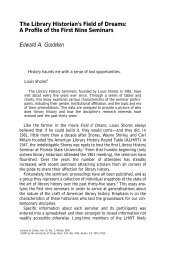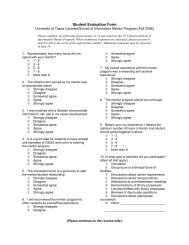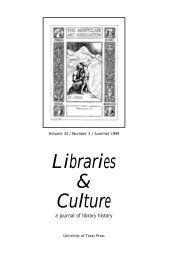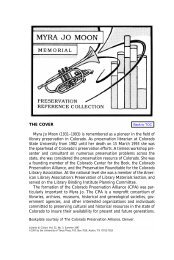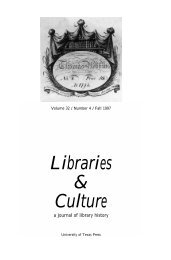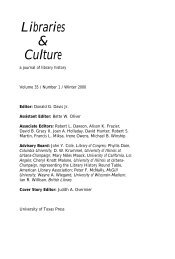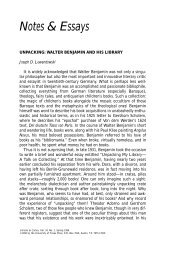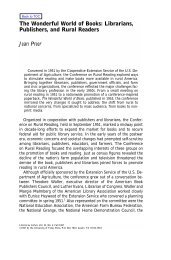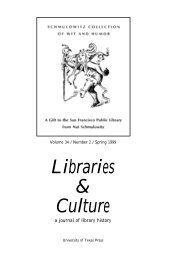The Library of the Royal Asiatic Society and Its Collections Relating ...
The Library of the Royal Asiatic Society and Its Collections Relating ...
The Library of the Royal Asiatic Society and Its Collections Relating ...
Create successful ePaper yourself
Turn your PDF publications into a flip-book with our unique Google optimized e-Paper software.
<strong>The</strong> <strong>Library</strong> <strong>of</strong> <strong>the</strong> <strong>Royal</strong> <strong>Asiatic</strong> <strong>Society</strong> <strong>and</strong><br />
<strong>Its</strong> <strong>Collections</strong> <strong>Relating</strong> to Sou<strong>the</strong>ast Asia<br />
M. J. Pollock<br />
Before describing <strong>the</strong> sou<strong>the</strong>ast Asian collections in detail, I would like<br />
to say something about <strong>the</strong> society <strong>and</strong> its library. <strong>The</strong> <strong>Royal</strong> <strong>Asiatic</strong><br />
<strong>Society</strong> is a learned society which was founded in 1823 by men, most <strong>of</strong><br />
whom had spent some time in Asia as civilian administrators or in <strong>the</strong><br />
army. It was founded to provide a forum in which new discoveries regarding<br />
Asia could be announced <strong>and</strong> discussed by like-minded people.<br />
<strong>Its</strong> strength, <strong>and</strong> at times its weakness, is that it has always been entirely<br />
independent <strong>of</strong> outside sources <strong>of</strong> money, whe<strong>the</strong>r government or commercial,<br />
<strong>and</strong> <strong>the</strong>refore independent <strong>of</strong> pressure to follow any particular<br />
course <strong>of</strong> research. <strong>The</strong> library is primarily for members <strong>of</strong> <strong>the</strong> society,<br />
but visitors with a serious interest in Asia may make appointments to<br />
see items in <strong>the</strong> collections.<br />
<strong>The</strong> society has occupied premises in six different buildings during <strong>the</strong><br />
172 years <strong>of</strong> its existence. <strong>The</strong> current building into which it moved in<br />
1988 is <strong>the</strong> first one which it has owned. Until 1869 <strong>the</strong> society also<br />
maintained a museum which reflected its commercial <strong>and</strong> scientific as<br />
well as its historical <strong>and</strong> antiquarian interests. It soon came to include<br />
coins, clothing, stuffed birds <strong>and</strong> animals, insects, <strong>and</strong> specimens <strong>of</strong> vegetable<br />
products from Africa, Oceana, <strong>and</strong> Australasia as well as Asia. In<br />
1828 a Captain Marryat deposited temporarily in <strong>the</strong> museum his collection<br />
<strong>of</strong> Burmese curiosities, which were <strong>the</strong> subject <strong>of</strong> several lectures.<br />
Donations in 1849 included Malay <strong>and</strong> Fijian weapons. In 1831 one <strong>of</strong><br />
<strong>the</strong> exhibits gave trouble. A mummy had been partially dissected <strong>and</strong><br />
‘‘in consequence <strong>of</strong> <strong>the</strong> unpleasant smell’’ <strong>the</strong> council agreed to <strong>of</strong>fer it<br />
to <strong>the</strong> Museum <strong>of</strong> Kings College, London University, which received it<br />
with thanks.<br />
In 1869 when <strong>the</strong> society had to move to smaller premises in Albermarle<br />
Street, most <strong>of</strong> <strong>the</strong> museum objects were transferred to <strong>the</strong> India<br />
Office in <strong>the</strong> hope that <strong>the</strong>y might be amalgamated with similar material<br />
from <strong>the</strong> old East India Company Museum. However, within a few years<br />
Libraries & Culture, Vol. 33, No. 3, Summer 1998<br />
1998 by <strong>the</strong> University <strong>of</strong> Texas Press, P.O. Box 7819, Austin, TX 78713-7819
307<br />
<strong>the</strong>se items were dispersed to o<strong>the</strong>r museums in London. It is still possible<br />
to trace <strong>the</strong> location <strong>of</strong> many <strong>of</strong> <strong>the</strong> objects formerly in <strong>the</strong> possession<br />
<strong>of</strong> <strong>the</strong> society, such as <strong>the</strong> Moghul jade cup dated 1022 A.H. (1613<br />
A.D.), which is now at <strong>the</strong> Victoria <strong>and</strong> Albert Museum, <strong>and</strong> a number<br />
<strong>of</strong> carved wooden clubs <strong>and</strong> spears from New Zeal<strong>and</strong>, which are now in<br />
<strong>the</strong> British Museum collections.<br />
For <strong>the</strong> first five years in <strong>the</strong> new building, from 1989 to 1994, <strong>the</strong><br />
library staff consisted <strong>of</strong> two people, myself <strong>and</strong> my predecessor as librarian,<br />
Godfrey Goodwin. This ensured a continuity which was invaluable<br />
to someone coming fresh to such a large variety <strong>of</strong> material.<br />
However with Goodwin’s retirement at <strong>the</strong> end <strong>of</strong> last year, <strong>the</strong> library<br />
staff is down to one person. <strong>The</strong> librarian <strong>of</strong> <strong>the</strong> society is in effect<br />
librarian, archivist, <strong>and</strong> curator <strong>and</strong> has charge <strong>of</strong> <strong>the</strong> following items:<br />
approximately 100,000 monographs; approximately 2,250 bound volumes<br />
<strong>of</strong> periodicals; over 1,140 boxes <strong>of</strong> periodical parts; seven bound volumes<br />
<strong>of</strong> early newspapers; approximately 300 bound volumes <strong>of</strong> pamphlets; a<br />
small collection <strong>of</strong> maps; approximately 2,000 Oriental manuscripts; ten<br />
collections <strong>of</strong> English-language personal papers; over 2,000 prints, paintings,<br />
drawings, busts, etc.; many albums <strong>and</strong> boxes <strong>of</strong> photographic<br />
prints; approximately 800 photographic glass plates; a wide variety <strong>of</strong><br />
miscellaneous ‘‘museum’’ items including copper-plate inscriptions, four<br />
bronze figures from sou<strong>the</strong>ast Asia; two swords; two wooden ‘‘folk’’ figures<br />
from sou<strong>the</strong>ast Asia; a Qajar ceramic bowl; a cast <strong>of</strong> a column with<br />
a Chola inscription from sou<strong>the</strong>rn India; a cast <strong>of</strong> a lion with a Hittite<br />
inscription; etc.<br />
<strong>The</strong> collections <strong>of</strong> <strong>the</strong> library are concerned with <strong>the</strong> history, geography,<br />
religions, philosophies, languages, arts, <strong>and</strong> literature <strong>of</strong> Asia. <strong>The</strong>re<br />
is some material on Hindu <strong>and</strong> Islamic law <strong>and</strong> <strong>the</strong> history <strong>of</strong> science in<br />
Asia, but <strong>the</strong>se subjects have not been actively collected by this library<br />
for a long time. <strong>The</strong>re is a small amount <strong>of</strong> material <strong>of</strong> ethnographical<br />
or anthropological interest, but this is also not an area in which <strong>the</strong><br />
library actively collects items.<br />
Asia is now defined as that area <strong>of</strong> <strong>the</strong> world which is not Europe,<br />
Africa, <strong>the</strong> Americas, or Australasia, although in <strong>the</strong> earlier years <strong>of</strong> <strong>the</strong><br />
society it meant anywhere east <strong>of</strong> Istanbul, including Australia, New<br />
Zeal<strong>and</strong>, <strong>and</strong> <strong>the</strong> western Pacific Ocean. For historical reasons, <strong>the</strong> collections<br />
are stronger in those geographical areas, such as India or<br />
Malaya, which were former colonial territories. <strong>The</strong> collections cover material<br />
relating to <strong>the</strong> last two thous<strong>and</strong> years, although we do not collect<br />
items relating to current affairs, this being defined very roughly as <strong>the</strong><br />
last thirty years or so.<br />
<strong>The</strong>re are catalogues or h<strong>and</strong>lists for almost all <strong>of</strong> <strong>the</strong> material in <strong>the</strong><br />
various collections owned by <strong>the</strong> society. Some <strong>of</strong> <strong>the</strong>se are fuller <strong>and</strong>
308 L&C/<strong>Library</strong> <strong>of</strong> <strong>the</strong> <strong>Royal</strong> <strong>Asiatic</strong> <strong>Society</strong><br />
more informative than o<strong>the</strong>rs, <strong>and</strong> I will try to elaborate on this as I<br />
come to relevant parts <strong>of</strong> <strong>the</strong> collections.<br />
In most categories <strong>of</strong> material <strong>the</strong> library has items relating to sou<strong>the</strong>ast<br />
Asia. <strong>The</strong>se have been acquired in a variety <strong>of</strong> ways—by purchase,<br />
donations, bequests, <strong>and</strong> exchange. <strong>The</strong>re is ano<strong>the</strong>r category <strong>of</strong> acquisitions<br />
for <strong>the</strong> items which come in for review in our journal.<br />
<strong>The</strong> society has been fortunate in having for much <strong>of</strong> its existence two<br />
sister societies in sou<strong>the</strong>ast Asia from which it has received periodicals<br />
<strong>and</strong> books in exchange for its own journal. <strong>The</strong> Straits Settlements<br />
branch <strong>of</strong> <strong>the</strong> <strong>Royal</strong> <strong>Asiatic</strong> <strong>Society</strong> was founded in 1878, became <strong>the</strong><br />
Malayan Branch in 1923, <strong>and</strong>, on independence, <strong>the</strong> Malaysian Branch<br />
in 1964. <strong>The</strong> o<strong>the</strong>r society was <strong>the</strong> oldest <strong>of</strong> all <strong>the</strong> Oriental societies,<br />
<strong>the</strong> Bataviaasch Genootschap van Kunsten en Wetenschappen [<strong>the</strong><br />
Batavian <strong>Society</strong> <strong>of</strong> Arts <strong>and</strong> Sciences], founded in 1778 in Batavia, now<br />
Jakarta, Indonesia. After <strong>the</strong> last war <strong>and</strong> Indonesian independence, this<br />
society became <strong>the</strong> Lembaga Kebudayan Indonesia [Indonesian Institute<br />
<strong>of</strong> Culture] from 1950 to 1962 <strong>and</strong> was <strong>the</strong>n disb<strong>and</strong>ed, <strong>the</strong> library becoming<br />
part <strong>of</strong> <strong>the</strong> National Museum.<br />
For well over one hundred years, <strong>the</strong> <strong>Library</strong> <strong>of</strong> <strong>the</strong> <strong>Royal</strong> <strong>Asiatic</strong> <strong>Society</strong><br />
has benefited from <strong>the</strong> exchange <strong>of</strong> monographs <strong>and</strong> periodicals<br />
with both <strong>of</strong> its sisters in sou<strong>the</strong>ast Asia <strong>and</strong> also from an exchange<br />
agreement with <strong>the</strong> Koninklijk Instituut voor Taal-. L<strong>and</strong>- en Volkenkunde<br />
(K.I.T.L.V.) in Leiden.<br />
<strong>The</strong> <strong>Library</strong>: Monograph <strong>Collections</strong><br />
<strong>The</strong> European-language monographs on subjects relating to sou<strong>the</strong>ast<br />
Asia are mostly in English, with some French <strong>and</strong> Dutch. For all <strong>the</strong><br />
monographs acquired before 1991, <strong>the</strong>re have always been author catalogues.<br />
<strong>The</strong> first catalogue <strong>of</strong> <strong>the</strong> library was published on 5 May 1830<br />
<strong>and</strong> listed 878 volumes. Books were listed by a number, within broad<br />
groups such as languages, history, philosophy, <strong>the</strong>ology, politics, etc. <strong>The</strong><br />
numbers beside <strong>the</strong> entries appear to be location numbers. Items <strong>of</strong><br />
sou<strong>the</strong>ast Asian interest appear quite early as number 29, which is in<br />
fact a volume <strong>of</strong> manuscript material, including an entry for <strong>the</strong> ‘‘true<br />
copy <strong>of</strong> <strong>the</strong> Pass from <strong>the</strong> King <strong>of</strong> Acheen for <strong>the</strong> grab ship Allum<br />
Shah.’’ I am not sure <strong>of</strong> <strong>the</strong> technical meaning <strong>of</strong> ‘‘grab ship’’ in <strong>the</strong><br />
1820s, but I would hesitate to describe this as a license for piracy, although<br />
<strong>the</strong> practice was common enough in sou<strong>the</strong>ast Asian waters at<br />
that period.<br />
<strong>The</strong> first printed item listed is number 51, a grammar <strong>of</strong> <strong>the</strong> T’hai,<br />
or Siamese language, by Captain James Low, 4TO, Calcutta, 1828. O<strong>the</strong>r<br />
early dictionaries <strong>and</strong> grammars appear in this section, including one for
309<br />
translating Dutch, French, <strong>and</strong> English into Malay, published in Haarlem<br />
in 1826, <strong>and</strong> a grammar <strong>of</strong> <strong>the</strong> Burman language with a list <strong>of</strong> <strong>the</strong> simple<br />
roots from whence <strong>the</strong> language is derived, by F. Carey, 8VO, Serampore,<br />
1814.<br />
Interest in strange plants <strong>and</strong> objects from strange places was in part<br />
satisfied by number 237 in <strong>the</strong> catalogue D’Amboinische Rareteitkamer [Cabinet<br />
<strong>of</strong> curiosities from Amboyna] door [by] George Everard Rumphius,<br />
Folio, T’Amsterdam, 1705. More conventional activities were presented<br />
in number 340, Proceedings <strong>of</strong> <strong>the</strong> Agricultural <strong>Society</strong>, established in<br />
Sumatra, 1820, vol. 1, 8vo, Bencoolen, 1821.<br />
<strong>The</strong>re is now a printed catalogue listing books received to about 1932<br />
<strong>and</strong> a card catalogue listing books received from 1932 to 1991. All acquisitions<br />
since July 1991 have been entered in a computerized catalogue.<br />
Until <strong>the</strong> introduction <strong>of</strong> a computerized catalogue, it was not possible<br />
to trace books by ei<strong>the</strong>r title word or subject. For <strong>the</strong> sou<strong>the</strong>ast Asian<br />
books this is now possible, as almost all <strong>the</strong> non-oriental-language books<br />
<strong>and</strong> some <strong>of</strong> <strong>the</strong> oriental-language ones relating to sou<strong>the</strong>ast Asia can<br />
now be found on <strong>the</strong> computerized catalogue.<br />
<strong>The</strong>re is quite a large ‘‘grey area’’ <strong>of</strong> monograph series like <strong>the</strong><br />
Publications <strong>of</strong> <strong>the</strong> École Française d’Extreme-Orient <strong>and</strong> <strong>the</strong> Verh<strong>and</strong>elingen<br />
<strong>of</strong> <strong>the</strong> Koninklijk Instituut voor Taal-, L<strong>and</strong>- en Volkenkunde.<br />
Some <strong>of</strong> <strong>the</strong>se have been kept toge<strong>the</strong>r <strong>and</strong> treated as serials under a<br />
collective series title, while o<strong>the</strong>rs are shelved separately as monographs<br />
<strong>and</strong> catalogued individually.<br />
<strong>The</strong>re are approximately 3,000 monograph titles relating to sou<strong>the</strong>ast<br />
Asia shelved on several floors throughout <strong>the</strong> building. Dictionaries <strong>and</strong><br />
grammars are kept in <strong>the</strong> basement, <strong>and</strong> in <strong>the</strong> lecture room on <strong>the</strong> first<br />
floor <strong>the</strong>re is a stack devoted to Burma. Apart from commercially published<br />
books about Burma, this section contains over 115 volumes <strong>of</strong><br />
<strong>of</strong>ficial gazetteers <strong>and</strong> approximately 25 publications by <strong>the</strong> Archaeological<br />
Survey <strong>of</strong> Burma.<br />
<strong>The</strong> main sou<strong>the</strong>ast Asia collection is on <strong>the</strong> second floor, <strong>and</strong> it covers<br />
<strong>the</strong> Malay/Indonesian world, Indochina, Thail<strong>and</strong>, <strong>and</strong> <strong>the</strong> Philippines.<br />
In addition to <strong>the</strong> European-language books on Thail<strong>and</strong>, <strong>the</strong>re is also<br />
on this floor a large number <strong>of</strong> Thai-language publications, including 113<br />
presented in 1926 by <strong>the</strong> Vajirayan National <strong>Library</strong> in Bangkok <strong>and</strong><br />
several more presented by King Prajaahipok in 1931. A small group <strong>of</strong><br />
books in Vietnamese published in <strong>the</strong> 1950s <strong>and</strong> 1960s has recently been<br />
given to <strong>the</strong> society. Most <strong>of</strong> <strong>the</strong>se non-European-language books do not<br />
yet appear in any <strong>of</strong> <strong>the</strong> library’s catalogues. In <strong>the</strong> basement are a<br />
number <strong>of</strong> books in Burmese as yet uncatalogued, still in <strong>the</strong> brown<br />
paper parcels in which <strong>the</strong>y arrived. It would appear from <strong>the</strong> labels on<br />
<strong>the</strong>se parcels that <strong>the</strong>se books are mostly translations <strong>of</strong> texts from
310 L&C/<strong>Library</strong> <strong>of</strong> <strong>the</strong> <strong>Royal</strong> <strong>Asiatic</strong> <strong>Society</strong><br />
English into Burmese published in <strong>the</strong> late 1940s <strong>and</strong> early 1950s.<br />
Underst<strong>and</strong>ably <strong>the</strong>ir cataloguing has taken a very low place on any list<br />
<strong>of</strong> priorities.<br />
<strong>The</strong> second floor is also used to house <strong>the</strong> publications <strong>of</strong> <strong>the</strong> Pali Text<br />
<strong>Society</strong>, but <strong>the</strong>se have recently been moved to <strong>the</strong> Reading Room on<br />
<strong>the</strong> ground floor where <strong>the</strong>y are shelved with o<strong>the</strong>r books relating to<br />
Buddhism. Many <strong>of</strong> <strong>the</strong>se volumes complement texts found in <strong>the</strong> Burmese,<br />
Thai, <strong>and</strong> Sinhalese manuscript collections.<br />
<strong>The</strong>re are a number <strong>of</strong> early printed items which may include rare, if<br />
not unique, copies <strong>of</strong> lithographed books. In 1991 Ian Proudfoot <strong>of</strong> <strong>the</strong><br />
faculty <strong>of</strong> Asian Studies at <strong>the</strong> Australian National University listed some<br />
55 items in this category which he found in <strong>the</strong> library <strong>of</strong> this society.<br />
In fact, 41 <strong>of</strong> <strong>the</strong>se are part <strong>of</strong> <strong>the</strong> Maxwell Collection <strong>of</strong> Malay material<br />
which includes a number <strong>of</strong> manuscripts. <strong>The</strong> entire Maxwell Collection,<br />
a bequest from Sir William E. Maxwell, a former colonial administrator<br />
in Malaya, is numbered in one manuscript sequence <strong>and</strong> kept in <strong>the</strong><br />
Strong Room.<br />
<strong>The</strong> <strong>Library</strong>: Periodical <strong>Collections</strong><br />
<strong>The</strong> library currently receives <strong>and</strong> keeps over 166 serial publications.<br />
Altoge<strong>the</strong>r <strong>the</strong>re are over 400 dead <strong>and</strong> current serial titles in <strong>the</strong> collections.<br />
Periodicals are not purchased but mostly acquired as part <strong>of</strong><br />
exchange agreements with o<strong>the</strong>r institutions or as gifts. This means that<br />
<strong>the</strong> periodicals collection is very uneven in its coverage as many good<br />
journals are commercial publications which <strong>the</strong> society cannot afford<br />
to buy.<br />
In <strong>the</strong> past, many periodicals were bound, especially those <strong>of</strong> sister<br />
societies like <strong>the</strong> Malayan Branch or <strong>the</strong> Bataviaasch Genootschap. However,<br />
<strong>the</strong> rising cost <strong>of</strong> binding meant that in <strong>the</strong> 1960s <strong>the</strong> library had<br />
to ab<strong>and</strong>on binding for all periodicals except its own journal.<br />
Records <strong>of</strong> periodical holdings are not always very good, partly because<br />
<strong>the</strong>re have been various methods <strong>of</strong> recording <strong>the</strong> receipt <strong>of</strong> new issues,<br />
<strong>and</strong> some <strong>of</strong> <strong>the</strong> earlier lists have not survived. However, all titles which<br />
have been identified in <strong>the</strong> collections are now listed <strong>and</strong> can be called<br />
up on <strong>the</strong> terminal in <strong>the</strong> library <strong>of</strong>fice. Considerable progress has been<br />
made in <strong>the</strong> last five years to record details <strong>of</strong> <strong>the</strong> holdings for <strong>the</strong>se<br />
titles, <strong>and</strong> this has been invaluable in checking <strong>the</strong> large numbers <strong>of</strong><br />
periodical parts among <strong>the</strong> recent bequests <strong>and</strong> donations.<br />
Three groups <strong>of</strong> donations received in <strong>the</strong> last year have enabled me<br />
to fill many gaps in our periodical holdings. In some cases individual<br />
issues have been added to complete a run <strong>of</strong> one title, <strong>and</strong> in o<strong>the</strong>r cases<br />
partial runs <strong>of</strong> new titles have been acquired.
<strong>The</strong> <strong>Library</strong>: Oriental Manuscript <strong>Collections</strong><br />
311<br />
<strong>The</strong> <strong>Royal</strong> <strong>Asiatic</strong> <strong>Society</strong> has a considerable number <strong>of</strong> manuscripts<br />
from both mainl<strong>and</strong> <strong>and</strong> isl<strong>and</strong> sou<strong>the</strong>ast Asia. <strong>The</strong>re are between 1,500<br />
<strong>and</strong> 2,000 oriental manuscripts in <strong>the</strong> collections. About one-third <strong>of</strong><br />
<strong>the</strong>se are from sou<strong>the</strong>ast Asia. Total numbers are hard to quantify because<br />
item numbers in lists <strong>and</strong> catalogues <strong>of</strong>ten cover more than one<br />
item, or are listed more than once under different headings. For example,<br />
<strong>Royal</strong> <strong>Asiatic</strong> <strong>Society</strong> Malay 142 contains some 36 separately listed<br />
items <strong>and</strong> <strong>Royal</strong> <strong>Asiatic</strong> <strong>Society</strong> Raffles Java 40 is, in effect, a Buginese-Makasarese<br />
vocabulary <strong>and</strong> has additional entries in lists <strong>of</strong> Buginese<br />
<strong>and</strong> Makasarese manuscripts.<br />
<strong>The</strong> manuscripts are printed on a variety <strong>of</strong> materials, most being on<br />
paper or palmleaf. <strong>The</strong>re are, however, a few quite exceptional items,<br />
including a copy <strong>of</strong> part <strong>of</strong> <strong>the</strong> Kammavaca on sixteen partly gilded,<br />
decorated ivory plates, <strong>and</strong> several on badly discolored silver. This discoloration<br />
has prevented <strong>the</strong>m from being fully identified, but conservation<br />
work is at h<strong>and</strong>, <strong>and</strong> I hope that it will be possible to make proper<br />
catalogue entries for <strong>the</strong>se items soon.<br />
<strong>The</strong> sou<strong>the</strong>ast Asian manuscripts were, with one exception, acquired<br />
in <strong>the</strong> nineteenth century: 10 Malay manuscripts presented by Sir<br />
William Farquhar (1827); 80 Malay manuscripts <strong>and</strong> 45 Javanese manuscripts<br />
from <strong>the</strong> collection <strong>of</strong> Sir Stamford Raffles presented by his widow<br />
(1830); <strong>the</strong> Gutzlaff collection <strong>of</strong> manuscripts from Thail<strong>and</strong>, Laos, <strong>and</strong><br />
Cambodia given by Sir Alex<strong>and</strong>er Johnston (1831); Burmese manuscripts<br />
presented by Sir Charles Hopkinson (1847); a copy <strong>of</strong> <strong>the</strong> Patimokkha<br />
(rules for Buddhist monks) presented by King Mongkut (Rama IV)<br />
(1858); a collection <strong>of</strong> Pali, Sinhalese, <strong>and</strong> Burmese manuscripts purchased<br />
by <strong>the</strong> <strong>Royal</strong> <strong>Asiatic</strong> <strong>Society</strong> from <strong>the</strong> executors <strong>of</strong> <strong>the</strong> Rev.<br />
Richard Morris (1896); 105 Malay ‘‘books’’ bequea<strong>the</strong>d to <strong>the</strong> society by<br />
Sir W. E. Maxwell (1899); 9 ‘‘Siamese’’ manuscripts presented by Dr.<br />
Quaritch Wales (1940s).<br />
<strong>The</strong> society’s Malay <strong>and</strong> Indonesian manuscripts were listed in Ricklefs<br />
<strong>and</strong> Voorhoeve’s Indonesian Manuscripts in Great Britain (London, 1977). In<br />
round numbers <strong>the</strong>se amount to: 1 Balinese, 3 Buginese, 50 Javanese, 1<br />
Madurese, 2 Makasarese, 142 Malay, 1 Moken, 3 Old Javanese, <strong>and</strong> 1<br />
Sudanese.<br />
<strong>The</strong> h<strong>and</strong>list <strong>of</strong> Burmese manuscripts suggests that <strong>the</strong>re were some<br />
80 items in <strong>the</strong> collection. Against many <strong>of</strong> <strong>the</strong> numbers on <strong>the</strong> list is<br />
<strong>the</strong> word ‘‘missing,’’ <strong>and</strong> this may be for one <strong>of</strong> several reasons. It is<br />
probable that <strong>the</strong>re has been confusion over <strong>the</strong> exact identity <strong>of</strong> some<br />
<strong>of</strong> <strong>the</strong> manuscripts <strong>and</strong> that parts <strong>of</strong> one longer work have been listed<br />
separately <strong>and</strong> later reunited.
312 L&C/<strong>Library</strong> <strong>of</strong> <strong>the</strong> <strong>Royal</strong> <strong>Asiatic</strong> <strong>Society</strong><br />
<strong>The</strong> h<strong>and</strong>list <strong>of</strong> ‘‘Siamese’’ manuscripts lists some 21 items. Again, it<br />
is not entirely clear whe<strong>the</strong>r <strong>the</strong>se are all still with <strong>the</strong> society. <strong>The</strong><br />
names Burmese <strong>and</strong> ‘‘Siamese’’ do not necessarily define <strong>the</strong> language<br />
<strong>of</strong> <strong>the</strong>se manuscripts but ra<strong>the</strong>r <strong>the</strong> script in which <strong>the</strong>y are written.<br />
Among <strong>the</strong> Burmese manuscripts are at least two in Shan, <strong>and</strong> <strong>the</strong><br />
‘‘Siamese’’ collection is said to have a few items in Laotian. Both <strong>of</strong> <strong>the</strong><br />
collections include a large number <strong>of</strong> Pali-language texts, as does our<br />
collection <strong>of</strong> Sinhalese manuscripts. <strong>The</strong> Burmese <strong>and</strong> ‘‘Siamese’’ manuscripts<br />
are <strong>the</strong> least well-known <strong>of</strong> <strong>the</strong> society’s oriental manuscripts,<br />
partly, it must be said, because <strong>the</strong>y have until recently been very inadequately<br />
catalogued.<br />
A major advance has been made in cataloguing this part <strong>of</strong> <strong>the</strong> collection<br />
with <strong>the</strong> draft ‘‘Survey <strong>of</strong> <strong>the</strong> Pali Manuscript Collection in <strong>the</strong><br />
<strong>Royal</strong> <strong>Asiatic</strong> <strong>Society</strong>’’ by Jacqueline Filliozat <strong>of</strong> <strong>the</strong> École Française<br />
d’Extrême-Orient. One pleasing discovery made as a result <strong>of</strong> Fillioz c at’s<br />
work was a manuscript which may well be <strong>the</strong> oldest manuscript on palm<br />
leaves kept in Europe, although <strong>the</strong>re are older ones on metal in a number<br />
<strong>of</strong> collections. It contains fragments <strong>of</strong> a mid-seventeenth-century<br />
royal manuscript commissioned by King Sirin<strong>and</strong>adhammaraja <strong>and</strong> his<br />
Queen Mahan<strong>and</strong>adevi. This manuscript is in three parts, <strong>the</strong> last being<br />
<strong>the</strong> Sahassavatthuppakarana, a series <strong>of</strong> paracanonical texts using popular<br />
folk stories, <strong>and</strong> belonging to <strong>the</strong> category <strong>of</strong> late medieval edifying<br />
Pali literature.<br />
<strong>The</strong> <strong>Library</strong>: Prints <strong>and</strong> Drawings<br />
<strong>The</strong>re are items <strong>of</strong> sou<strong>the</strong>ast Asian interest in five collections from<br />
<strong>the</strong> library’s many prints, drawings, etc. <strong>The</strong>se were described in detail<br />
in <strong>the</strong> ‘‘Catalogue <strong>of</strong> Paintings, Drawings, Engravings <strong>and</strong> Busts in <strong>the</strong><br />
Collection <strong>of</strong> <strong>the</strong> <strong>Royal</strong> <strong>Asiatic</strong> <strong>Society</strong>,’’ by Raymond Head. London,<br />
<strong>Royal</strong> <strong>Asiatic</strong> <strong>Society</strong>, 1991.<br />
<strong>The</strong> first group, <strong>of</strong> 137 items, is <strong>the</strong> Baker Collection, numbered 08.00-<br />
08.137. Lt. Col. Godfrey Phipps Baker (1796–1850), 19th Bengal Native<br />
Infantry, spent <strong>the</strong> years 1811 through 1826 in Java during <strong>the</strong> British<br />
occupation <strong>of</strong> that isl<strong>and</strong>. He was responsible for undertaking surveys<br />
<strong>and</strong> superintending buildings. In 1812 his orders from <strong>the</strong> <strong>the</strong>n British<br />
Resident at Jogjakarta were to ‘‘make plans <strong>of</strong> <strong>the</strong> neighbouring country,<br />
such as would answer military purposes, tho’ without <strong>the</strong> employment <strong>of</strong><br />
instruments. This could be effected without giving unnecessary alarm to<br />
<strong>the</strong> Sultan.’’ Many <strong>of</strong> <strong>the</strong> watercolors <strong>and</strong> drawings in this collection are<br />
<strong>of</strong> buildings, including <strong>the</strong> ruins at Ch<strong>and</strong>i Arjuna on <strong>the</strong> Dieng Plateau<br />
<strong>and</strong> at Borobodur.
313<br />
O<strong>the</strong>r drawings by Baker are in <strong>the</strong> Oriental <strong>and</strong> India Office <strong>Collections</strong><br />
<strong>of</strong> <strong>the</strong> British <strong>Library</strong> <strong>and</strong> in <strong>the</strong> British Museum. <strong>The</strong> items in <strong>the</strong><br />
<strong>Royal</strong> <strong>Asiatic</strong> <strong>Society</strong> collection were presented to <strong>the</strong> society on 2 February<br />
1850 by a Captain Richard Hunt, who later gave a copy <strong>of</strong> Baker’s<br />
journal to <strong>the</strong> India Office <strong>Library</strong>. A letter from Baker to Hunt is bound<br />
to this volume, so it is clear that Baker <strong>and</strong> Hunt knew each o<strong>the</strong>r, but<br />
it is not at all clear how Baker’s papers <strong>and</strong> drawings came to be distributed<br />
through three different institutions.<br />
<strong>The</strong> second group, <strong>the</strong> Low Collection, consists <strong>of</strong> some twenty items.<br />
Lt. Col. James Low, 46th Madras Native Infantry, is <strong>the</strong> same man who<br />
wrote <strong>the</strong> T’hai dictionary listed in <strong>the</strong> 1830 catalogue mentioned above.<br />
Low was in civil charge <strong>of</strong> Province Wellesley, inl<strong>and</strong> <strong>of</strong> Penang on <strong>the</strong><br />
Malay peninsula. <strong>The</strong>se drawings <strong>of</strong> Thail<strong>and</strong> <strong>and</strong> Burma were by Low<br />
<strong>and</strong> a Thai or Chinese artist ‘‘Boon Khorn’’ <strong>and</strong> were intended for a<br />
book by Low to be called History <strong>of</strong> Tennasserim.<br />
<strong>The</strong> third group, <strong>the</strong> Unwin Collection, includes sixteen watercolors<br />
<strong>and</strong> drawings <strong>of</strong> Burma. Arthur Hamilton Unwin was an assistant commissioner<br />
<strong>and</strong> inspector <strong>of</strong> schools in Burma from 1873 through 1880.<br />
<strong>The</strong>se paintings by Unwin <strong>and</strong> his wife are perhaps valuable more because<br />
<strong>of</strong> <strong>the</strong> relative rarity <strong>of</strong> such items than because <strong>of</strong> <strong>the</strong>ir artistic merit.<br />
<strong>The</strong> fourth group consists <strong>of</strong> four paintings by Burmese artists in<br />
gouache, with some gilding. <strong>The</strong> largest is <strong>of</strong> <strong>the</strong> Palace <strong>of</strong> <strong>the</strong> King at<br />
Ava, <strong>and</strong> <strong>the</strong> o<strong>the</strong>rs are <strong>of</strong> Prince Thibaw <strong>and</strong> his wives.<br />
<strong>The</strong> <strong>Library</strong>: Pamphlets <strong>and</strong> Newspapers<br />
<strong>The</strong> library has many bound volumes <strong>of</strong> pamphlets <strong>and</strong> tracts, <strong>and</strong> it<br />
is certain that some <strong>of</strong> <strong>the</strong>se relate to sou<strong>the</strong>ast Asia, but locating relevant<br />
items is difficult. Some <strong>of</strong> <strong>the</strong> earlier pamphlets appear in <strong>the</strong><br />
printed catalogue <strong>of</strong> 1893, although all is not always what it seems to<br />
be. In this catalogue, volume 34 <strong>of</strong> <strong>the</strong> pamphlet sequence has <strong>the</strong> following<br />
entry: ‘‘MILLER, J. Administration <strong>of</strong> justice in <strong>the</strong> British colonies<br />
in <strong>the</strong> East Indies. 150 p. London. 1828.’’ This is indeed <strong>the</strong> title on<br />
<strong>the</strong> title page, but <strong>the</strong> running title for each page <strong>of</strong> this work is Administration<br />
<strong>of</strong> Justice in India. It is clear that <strong>the</strong> description ‘‘East<br />
Indies’’ is used in <strong>the</strong> loose eighteenth- <strong>and</strong> nineteenth-century meaning<br />
ra<strong>the</strong>r than <strong>the</strong> more exact twentieth-century one. However, <strong>the</strong> entry<br />
in Volume 77, ‘‘INDIAN ARCHIPELAGO. A system <strong>of</strong> classification <strong>and</strong><br />
orthography <strong>of</strong> <strong>the</strong> languages [n.p., n.d.],’’ does produce an interesting<br />
pamphlet <strong>of</strong> 32 pages. As <strong>the</strong> paper cover is missing, it is difficult to<br />
identify <strong>the</strong> origins <strong>of</strong> <strong>the</strong>se works. A third item, listed in volume 68 as<br />
‘‘LEEMANS, C. Over metalen Beeldjes uit Java’’ is 29 pages long <strong>and</strong>
314 L&C/<strong>Library</strong> <strong>of</strong> <strong>the</strong> <strong>Royal</strong> <strong>Asiatic</strong> <strong>Society</strong><br />
dated Leiden, November 1857 at <strong>the</strong> end. Fur<strong>the</strong>r work on <strong>the</strong>se pamphlets<br />
is needed, but under current priorities <strong>the</strong> monographs take<br />
precedence.<br />
Copies <strong>of</strong> two sou<strong>the</strong>ast Asian newspapers have survived in <strong>the</strong> library,<br />
although most <strong>of</strong> what was once a much larger collection was disposed<br />
<strong>of</strong> a long time ago. <strong>The</strong>se have been bound into two volumes (each taking<br />
a few issues): ‘‘SINGAPORE CHRONICLE No. 99 January 1828—No.<br />
150 December 1829’’ <strong>and</strong> ‘‘COMMERCIAL REGISTER AND ADVER-<br />
TISER. Singapore. No. 84 January 1828—No. 185 December 1829.’’<br />
Donations <strong>and</strong> Bequests<br />
<strong>The</strong> <strong>Library</strong> <strong>of</strong> <strong>the</strong> <strong>Royal</strong> <strong>Asiatic</strong> <strong>Society</strong> has been very fortunate in<br />
<strong>the</strong> last year in that it has received two bequests <strong>and</strong> a donation <strong>of</strong><br />
material, much <strong>of</strong> which relates to Sou<strong>the</strong>ast Asia. <strong>The</strong> first bequest<br />
came from Dorothy C. Wales, widow <strong>of</strong> Horace G. Quaritch Wales, a<br />
scholar <strong>of</strong> early Sou<strong>the</strong>ast Asian history who died in 1981. Apart from<br />
some fine antique library furniture, some <strong>of</strong> which now gives a greatly<br />
improved appearance to <strong>the</strong> librarian’s <strong>of</strong>fice <strong>and</strong> comfort to <strong>the</strong> librarian,<br />
<strong>the</strong>re is a wide variety <strong>of</strong> o<strong>the</strong>r items. In addition to manuscript<br />
material which includes notebooks <strong>and</strong> tour diaries relating to researches<br />
in Sou<strong>the</strong>ast Asia in <strong>the</strong> 1930s, <strong>the</strong>re were periodicals, books, photographs,<br />
scrapbooks containing newspaper cuttings relating to events in<br />
Thail<strong>and</strong> in <strong>the</strong> 1930s, some small sculptures, <strong>and</strong> a small Thai manuscript<br />
chest decorated in black <strong>and</strong> gold. <strong>The</strong> books which were added<br />
to stock have all been processed, <strong>and</strong> gaps in our periodical holdings<br />
have been reduced <strong>and</strong> in one case eliminated. It will be some time,<br />
however, before a proper assessment can be made <strong>of</strong> <strong>the</strong> photographs<br />
<strong>and</strong> manuscript material.<br />
<strong>The</strong> second bequest, <strong>of</strong> some twenty-two boxes <strong>of</strong> material, came from<br />
Mr. Anthony Christie, an anthropologist <strong>and</strong> ethnographer, whose interests<br />
covered China, Japan, <strong>and</strong> Sou<strong>the</strong>ast Asia. This collection consists<br />
largely <strong>of</strong> books, periodicals, <strong>and</strong> typescript notes. <strong>The</strong> periodicals again<br />
supplied items to fill gaps in our own holdings, <strong>and</strong> a start has been<br />
made on checking <strong>the</strong> books against our catalogues. It is clear that <strong>the</strong><br />
library has been fortunate in acquiring a number <strong>of</strong> books on Asian art,<br />
iconography, <strong>and</strong> es<strong>the</strong>tics. This is an area in which we were previously<br />
ra<strong>the</strong>r weak. Although <strong>the</strong> library already has a large number <strong>of</strong> books<br />
on pure religion <strong>and</strong> philosophy, this gift added a number <strong>of</strong> items on<br />
<strong>the</strong> ways in which various Asian societies were <strong>and</strong> are molded by <strong>the</strong>ir<br />
beliefs.<br />
<strong>The</strong> third group <strong>of</strong> material comes from D. J. Duncanson, a former<br />
director <strong>and</strong> currently vice-president <strong>of</strong> this society. Duncanson worked
315<br />
in Malaya <strong>and</strong> Vietnam through <strong>the</strong> 1950s <strong>and</strong> 1960s, <strong>and</strong> later, on his<br />
return to Britain, he was a member <strong>of</strong> <strong>the</strong> academic staff at Kent University.<br />
His books, periodicals, <strong>and</strong> pamphlets reflect his interest in <strong>the</strong><br />
history <strong>and</strong> government <strong>of</strong> Malaya <strong>and</strong> Vietnam as well as his o<strong>the</strong>r great<br />
interest, China. This third group was <strong>the</strong> most recent, <strong>and</strong> it will be<br />
some time before an accurate assessment <strong>of</strong> <strong>the</strong> total additions to <strong>the</strong><br />
library can be made.<br />
<strong>The</strong> <strong>of</strong>fer <strong>of</strong> such a large quantity <strong>of</strong> material from <strong>the</strong>se three sources<br />
in a relatively short space <strong>of</strong> time has brought with it inevitable problems<br />
<strong>of</strong> indigestion in a library system whose normal budgetary limits ensure<br />
that accessions are relatively few over a longer period <strong>of</strong> time. However,<br />
<strong>the</strong>se financial limitations also mean that <strong>the</strong> library cannot afford to<br />
let such <strong>of</strong>fers slip by.<br />
Conclusions<br />
Although I have spent most <strong>of</strong> my pr<strong>of</strong>essional career working in libraries<br />
with large oriental collections, I am not an orientalist. This has<br />
certain disadvantages, <strong>and</strong> what I like to think are certain advantages.<br />
My background knowledge <strong>of</strong> Asia comes from a variety <strong>of</strong> sources,<br />
starting with a childhood in which <strong>the</strong> neighbors were retired Indian<br />
empire administrators <strong>and</strong> soldiers. University-level courses in Chinese<br />
<strong>and</strong> Malay history were followed by holiday travel in China, including<br />
Sinkiang, Indonesia, India, Pakistan, <strong>and</strong> three visits to Istanbul. Working<br />
with oriental collections, I have had access to books on almost every<br />
Asian subject, <strong>and</strong> I have read widely, if not necessarily deeply.<br />
My knowledge <strong>of</strong> spoken Asian languages is limited to a few phrases<br />
<strong>of</strong> Bahasa Indonesian <strong>and</strong> M<strong>and</strong>arin <strong>and</strong> ra<strong>the</strong>r more Hindustani. I can<br />
transliterate from Devanagari, <strong>the</strong> script used for north Indian languages,<br />
<strong>and</strong> recognize Arabic <strong>and</strong> Persian numerals. I can recognize <strong>the</strong><br />
wide variety <strong>of</strong> scripts used for items in <strong>the</strong> library <strong>of</strong> <strong>the</strong> <strong>Royal</strong> <strong>Asiatic</strong><br />
<strong>Society</strong> but not always <strong>the</strong> language. When I am confronted with a book<br />
whose script is clearly Arabic, but whose language might be Arabic, Persian,<br />
Punjabi, Sindhi, Ottoman Turkish, Uighur, or even Malay, I have<br />
to rely on suitable members <strong>of</strong> <strong>the</strong> society to help.<br />
I would argue, however, that my generalist knowledge, acquired<br />
through a variety <strong>of</strong> means, has enabled me to cope more easily with <strong>the</strong><br />
enormous scope <strong>of</strong> <strong>the</strong> collections at <strong>the</strong> <strong>Royal</strong> <strong>Asiatic</strong> <strong>Society</strong>. For example,<br />
I recently came across a book which had been placed in <strong>the</strong> wrong<br />
subject group on <strong>the</strong> wrong floor, solely because a previous library worker<br />
had mistaken Chamba, a small hill state on <strong>the</strong> borders <strong>of</strong> <strong>the</strong> Punjab<br />
<strong>and</strong> Kashmir, for Champa, <strong>the</strong> early medieval state on <strong>the</strong> sou<strong>the</strong>rn coast<br />
<strong>of</strong> what is now Vietnam.
316 L&C/<strong>Library</strong> <strong>of</strong> <strong>the</strong> <strong>Royal</strong> <strong>Asiatic</strong> <strong>Society</strong><br />
Not being a subject specialist forces me to take a broad view <strong>of</strong> <strong>the</strong><br />
collections as a whole. I can not hide in <strong>the</strong> satisfaction <strong>of</strong> making one<br />
small area <strong>of</strong> <strong>the</strong> collections an example <strong>of</strong> all that area should be.<br />
Ra<strong>the</strong>r I am faced with <strong>the</strong> enormity <strong>of</strong> turning what is in many respects<br />
a nineteenth-century library into a late-twentieth-century or even<br />
twenty-first-century one. I am <strong>the</strong> first pr<strong>of</strong>essionally qualified librarian<br />
that <strong>the</strong> library has had, many <strong>of</strong> <strong>the</strong> previous occupants <strong>of</strong> that post<br />
having been scholars or secretaries who administered <strong>the</strong> library.<br />
When <strong>the</strong> society was founded, serious oriental studies were in <strong>the</strong>ir<br />
infancy, <strong>and</strong> <strong>the</strong> society performed a useful function as a forum for <strong>the</strong><br />
dissemination <strong>of</strong> new knowledge about Asia. Now, however, centers for<br />
<strong>the</strong> study <strong>of</strong> aspects <strong>of</strong> Asia are everywhere. Many <strong>of</strong> <strong>the</strong>se centers are<br />
relatively recent, <strong>and</strong> <strong>the</strong>ir libraries are <strong>of</strong>ten lacking older books <strong>and</strong><br />
periodicals. Larger numbers <strong>of</strong> students also make considerable dem<strong>and</strong>s<br />
on <strong>the</strong> libraries <strong>of</strong> <strong>the</strong>se institutions. In addition, <strong>the</strong>re are a great many<br />
individuals with a private interest in some aspect <strong>of</strong> Asia, people who<br />
have no access to <strong>the</strong> libraries <strong>of</strong> educational institutions. I see an important<br />
future for libraries like that <strong>of</strong> <strong>the</strong> <strong>Royal</strong> <strong>Asiatic</strong> <strong>Society</strong> in acting<br />
as backup collections <strong>of</strong> older <strong>and</strong> rarer material for formal courses <strong>and</strong><br />
educational institutions, <strong>and</strong> as a means by which individuals can have<br />
access to information which is not easily available elsewhere.



